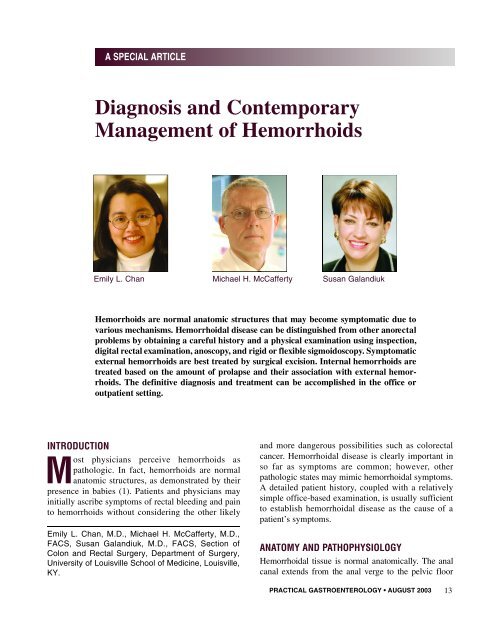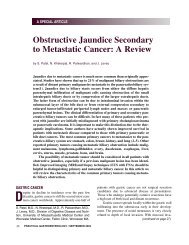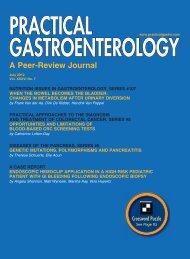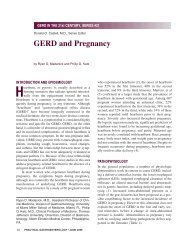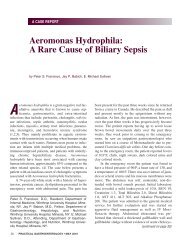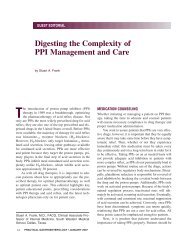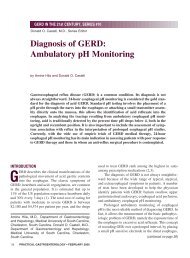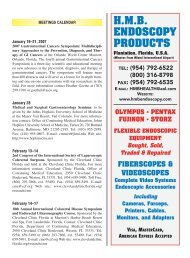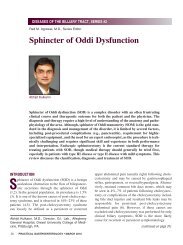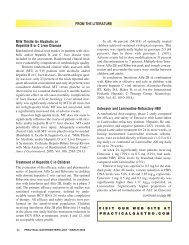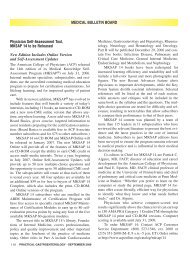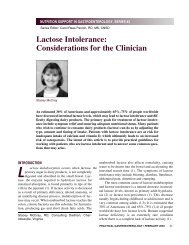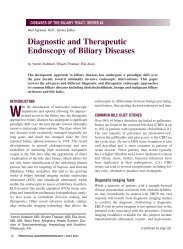Diagnosis and Contemporary Management of Hemorrhoids
Diagnosis and Contemporary Management of Hemorrhoids
Diagnosis and Contemporary Management of Hemorrhoids
Create successful ePaper yourself
Turn your PDF publications into a flip-book with our unique Google optimized e-Paper software.
A SPECIAL ARTICLE<br />
<strong>Diagnosis</strong> <strong>and</strong> <strong>Contemporary</strong><br />
<strong>Management</strong> <strong>of</strong> <strong>Hemorrhoids</strong><br />
Emily L. Chan Michael H. McCafferty Susan Gal<strong>and</strong>iuk<br />
H e m o r rhoids are normal anatomic structures that may become symptomatic due to<br />
various mechanisms. Hemorrhoidal disease can be distinguished from other anore c t a l<br />
p roblems by obtaining a careful history <strong>and</strong> a physical examination using inspection,<br />
digital rectal examination, anoscopy, <strong>and</strong> rigid or flexible sigmoidoscopy. Symptomatic<br />
external hemorrhoids are best treated by surgical excision. Internal hemorrhoids are<br />
t reated based on the amount <strong>of</strong> prolapse <strong>and</strong> their association with external hemorrhoids.<br />
The definitive diagnosis <strong>and</strong> treatment can be accomplished in the <strong>of</strong>fice or<br />
outpatient setting.<br />
INTRODUCTION<br />
Most physicians perceive hemorrhoids as<br />
pathologic. In fact, hemorrhoids are normal<br />
anatomic structures, as demonstrated by their<br />
presence in babies (1). Patients <strong>and</strong> physicians may<br />
initially ascribe symptoms <strong>of</strong> rectal bleeding <strong>and</strong> pain<br />
to hemorrhoids without considering the other likely<br />
Emily L. Chan, M.D., Michael H. McCafferty, M.D.,<br />
FACS, Susan Gal<strong>and</strong>iuk, M.D., FACS, Section <strong>of</strong><br />
Colon <strong>and</strong> Rectal Surgery, Department <strong>of</strong> Surgery,<br />
University <strong>of</strong> Louisville School <strong>of</strong> Medicine, Louisville,<br />
KY.<br />
<strong>and</strong> more dangerous possibilities such as colorectal<br />
cancer. Hemorrhoidal disease is clearly important in<br />
so far as symptoms are common; however, other<br />
pathologic states may mimic hemorrhoidal symptoms.<br />
A detailed patient history, coupled with a relatively<br />
simple <strong>of</strong>fice-based examination, is usually sufficient<br />
to establish hemorrhoidal disease as the cause <strong>of</strong> a<br />
patient’s symptoms.<br />
ANATOMY AND PATHOPHYSIOLOGY<br />
Hemorrhoidal tissue is normal anatomically. The anal<br />
canal extends from the anal verge to the pelvic floor<br />
PRACTICAL GASTROENTEROLOGY • AUGUST 2003 13
<strong>Diagnosis</strong> <strong>and</strong> <strong>Contemporary</strong> <strong>Management</strong> <strong>of</strong> <strong>Hemorrhoids</strong><br />
A SPECIAL ARTICLE<br />
Figure 1. Schematic view <strong>of</strong> lower rectum <strong>and</strong> anal canal.<br />
(Figure 1). The lower half <strong>of</strong> the anal canal is lined by<br />
squamous epithelium, <strong>and</strong> the upper anal canal above<br />
the pectinate line is lined by columnar epithelium. Internal<br />
hemorrhoids are located above the pectinate line <strong>and</strong><br />
are lined by columnar epithelium. External hemorrhoids<br />
are covered by squamous epithelium. Anatomically,<br />
Table 1<br />
How to Differentiate Between External <strong>and</strong> Internal <strong>Hemorrhoids</strong><br />
14<br />
External <strong>Hemorrhoids</strong> Internal <strong>Hemorrhoids</strong><br />
Location Below dentate line Above dentate line<br />
Covering Anoderm Rectal mucosa<br />
(squamous epithelium) (columnar epithelium)<br />
Symptoms Acutely painful Not painful<br />
Treatment Excision Depends on degree <strong>of</strong> prolapse<br />
Signs Occur in clusters<br />
External <strong>and</strong> Internal <strong>Hemorrhoids</strong><br />
Exacerbating factors Constipation<br />
Increased intra-abdominal pressure<br />
Valsalva maneuvers<br />
Pregnancy<br />
Heavy lifting<br />
Heavy sports<br />
PRACTICAL GASTROENTEROLOGY • AUGUST 2003<br />
there are three dominant sets <strong>of</strong> internal<br />
<strong>and</strong> external hemorrhoids situated in the<br />
left lateral, right anterior, <strong>and</strong> the right<br />
posterior positions (Figure 2). <strong>Hemorrhoids</strong><br />
are characterized histologically by<br />
a thick submucosa composed <strong>of</strong> blood<br />
vessels with some smooth muscle, elastic<br />
fibers, <strong>and</strong> connective tissue. These vascular<br />
cushions are believed to actually<br />
contribute to finer control <strong>of</strong> continence.<br />
The sensory innervation <strong>of</strong> the internal<br />
<strong>and</strong> external hemorrhoids also differs. The<br />
mucosa overlying internal hemorrhoids<br />
senses pressure <strong>and</strong> is relatively insensitive<br />
to pain, whereas the squamous epithelium<br />
overlying the external hemorrhoids<br />
has exquisite sensitivity to painful stimuli.<br />
Both the sensory innervation <strong>and</strong> epithelial surface lining<br />
explain the significant differences in symptoms with<br />
pathologic enlargement <strong>of</strong> these hemorrhoids (Table 1).<br />
The pathogenesis <strong>of</strong> abnormally enlarged <strong>and</strong><br />
symptomatic hemorrhoids has been explained by several<br />
theories, including varicose veins, vascular hyperplasia,<br />
<strong>and</strong> sliding anal lining theory<br />
(1). Regardless <strong>of</strong> the underlying<br />
abnormality producing symptomatic<br />
hemorrhoids, faulty diet <strong>and</strong> bowel<br />
habits contribute to symptomatic hemorrhoids.<br />
Constipation, as defined by<br />
infrequent hard bowel movements or<br />
prolonged straining to defecate, is<br />
undesirable <strong>and</strong> contributes to more<br />
engorgement <strong>of</strong> the hemorrhoidal tissue<br />
than occurs with more frequent,<br />
easier bowel actions.<br />
HISTORY<br />
Myriad anorectal complaints can arise<br />
from hemorrhoids. Bleeding <strong>and</strong><br />
swelling are the two most common<br />
symptoms (2). Bleeding arises from<br />
irritation <strong>of</strong> the fragile lining overlying<br />
the internal hemorrhoids <strong>and</strong> is characteristically<br />
painless <strong>and</strong> bright red.<br />
(continued on page 17)
(continued from page 14)<br />
Figure 2. Prolapsed internal hemorrhoids (arrow).<br />
RP = right posterior quadrant. RA = right anterior<br />
quadrant. LL = left lateral quadrant.*<br />
There may be a minimal amount <strong>of</strong> red blood present<br />
on tissue paper upon wiping or an impressive amount<br />
such as red blood squirting into the toilet bowl during<br />
defecation. Sometimes the patient will notice red blood<br />
striping the side <strong>of</strong> the stool as it passes over an irritated<br />
internal hemorrhoid. If there is significant prolapse <strong>of</strong><br />
the inflamed hemorrhoid, <strong>and</strong> the prolapsed hemorrhoid<br />
does not spontaneously reduce in size, there may<br />
be bloody staining or frank bleeding onto the underclothing.<br />
Similarly, prolapsing internal hemorrhoids<br />
may also lead to symptoms <strong>of</strong> minor fecal incontinence.<br />
The status <strong>of</strong> a patient’s sphincter influences the<br />
symptoms. Elderly patients with diminished sphincter<br />
tone will tend to have prolapsed internal hemorrhoids<br />
<strong>and</strong> may have a component <strong>of</strong> fecal staining, along with<br />
a mucous discharge caused from prolapse <strong>and</strong> wicking<br />
<strong>of</strong> fecal debris along the prolapsed hemorrhoids. This<br />
produces both a hygiene problem <strong>and</strong> itching.<br />
It is important to recognize that other conditions<br />
can produce symptoms identical to those described<br />
above. Bleeding from a hemorrhoid must be distinguished<br />
from bleeding from colorectal cancer, an anal<br />
fissure, proctitis, or severe pruritus. Typically, bleeding<br />
from a malignancy is associated with some mucus,<br />
although the same can hold true with hemorrhoidal<br />
<strong>Diagnosis</strong> <strong>and</strong> <strong>Contemporary</strong> <strong>Management</strong> <strong>of</strong> <strong>Hemorrhoids</strong><br />
A SPECIAL ARTICLE<br />
bleeding, particularly with prolapse. In addition, colorectal<br />
cancer is <strong>of</strong>ten associated with some alteration<br />
in bowel habits, which is not expected with hemorrhoidal<br />
bleeding. While a small amount <strong>of</strong> bleeding is<br />
common, pain is the dominant complaint among<br />
patients with anal fissures. Pain associated with anal<br />
fissures characteristically is exacerbated by bowel<br />
movements. Proctitis can produce significant bleeding,<br />
but usually is associated with mucus <strong>and</strong> more urgency<br />
resulting from the inflammatory process involving the<br />
rectum. In patients with limited, very distal proctitis,<br />
however, the symptoms can be identical to the bleeding<br />
associated with internal hemorrhoids. Pruritus ani<br />
with significant perianal excoriation can certainly produce<br />
red bleeding, but the symptoms secondary to irritation<br />
<strong>of</strong> the skin usually predominate. Rarely, severe<br />
hemorrhoidal bleeding can produce anemia <strong>and</strong><br />
require transfusion. Even when there is typical hemorrhoidal<br />
bleeding <strong>and</strong> little else to suggest a more proximal<br />
lesion, a full evaluation <strong>of</strong> the colon must be<br />
done, especially when the patient has anemia, a family<br />
history <strong>of</strong> colorectal cancer, or a personal history <strong>of</strong><br />
colorectal polyps or cancer (3).<br />
Swelling associated with hemorrhoids can result<br />
from prolapsed internal hemorrhoids or external hemorrhoids.<br />
Other than the swelling, the symptoms differ.<br />
Internal hemorrhoids that prolapse may produce pressure<br />
<strong>and</strong> some mucous <strong>and</strong>/or bloody soiling. Acute<br />
(continued on page 20)<br />
Figure 3. Acutely thrombosed external hemorrhoid.*<br />
PRACTICAL GASTROENTEROLOGY • AUGUST 2003 17
<strong>Diagnosis</strong> <strong>and</strong> <strong>Contemporary</strong> <strong>Management</strong> <strong>of</strong> <strong>Hemorrhoids</strong><br />
A SPECIAL ARTICLE<br />
(continued from page 17)<br />
external hemorrhoidal swelling is usually very painful<br />
<strong>and</strong> not associated with bleeding or mucus discharge.<br />
An acutely swollen, painful, perianal nodule is usually<br />
due to a thrombosed external hemorrhoid (Figure 3).<br />
Thrombosed hemorrhoids may involve both the<br />
internal <strong>and</strong> external components, or one or the other<br />
i n d e p e n d e n t l y. More commonly, isolated external<br />
hemorrhoidal thrombosis will occur at a single site,<br />
although a patient may have thromboses <strong>of</strong> multiple<br />
hemorrhoids externally or in combination with thromboses<br />
<strong>of</strong> the internal hemorrhoids. This will frequently<br />
occur or worsen during the third trimester <strong>of</strong> pregnancy<br />
or in the immediate postpartum period. The<br />
patient may view this situation as an emergency<br />
because <strong>of</strong> the significant associated discomfort.<br />
Within the first few days <strong>of</strong> the thrombotic event, the<br />
pain, edema, <strong>and</strong> tenderness are impressive <strong>and</strong> significant;<br />
however, by about 5 or 6 days after the initial<br />
thrombosis, the inflammatory reaction <strong>and</strong> edema<br />
begin to subside, <strong>and</strong> the patient has less pain. Along<br />
the way, pressure necrosis <strong>of</strong> the overlying skin or<br />
mucosa overlying a thrombosed internal hemorrhoid<br />
may develop. The patient may notice the passage <strong>of</strong><br />
clotted blood <strong>and</strong> perhaps some fresh red blood. At the<br />
same time, the tense swelling <strong>of</strong> the thrombosed hemorrhoid<br />
may decrease, <strong>and</strong> the pain will diminish.<br />
PATIENT EVALUATION<br />
The first step in evaluating the patient with suspected<br />
hemorrhoidal symptoms is to obtain a complete history,<br />
which should include the following:<br />
• Elicit typical symptoms.<br />
• Determine whether the symptoms relate to internal or<br />
external hemorrhoids or both.<br />
• Inquire as to the patient’s bowel habits (i.e., if there<br />
are any changes in stool frequency, consistency, size).<br />
• Determine the nature <strong>and</strong> character <strong>of</strong> any bleeding,<br />
<strong>and</strong> consider further work-up to rule out a proximal<br />
gastrointestinal source.<br />
• Determine whether the patient has a family history<br />
<strong>of</strong> colon or rectal neoplasia or inflammatory bowel<br />
disease.<br />
A physical examination begins with inspection <strong>of</strong><br />
the perianal area. Enlarged external hemorrhoids<br />
should be noted along with any evidence <strong>of</strong> acute<br />
20<br />
PRACTICAL GASTROENTEROLOGY • AUGUST 2003<br />
Table 2<br />
Grading System for Internal <strong>Hemorrhoids</strong><br />
<strong>Hemorrhoids</strong> Symptoms<br />
First-degree Bleed but do not prolapse<br />
Second-degree Prolapse to beyond the anal verge with<br />
defecation but spontaneously reduce<br />
after defecation<br />
Third-degree Prolapse with defecation but require<br />
digital reduction<br />
Fourth-degree Non-reducible prolapsed internal<br />
hemorrhoids<br />
Figure 4. Rectal prolapse. Note the concentric folds, unlike<br />
the hemorrhoidal clusters seen in Figure 2.*<br />
thromboses. Careful digital rectal examination is then<br />
undertaken to determine whether other anal canal or<br />
distal rectal pathology is present, such as a painful anal<br />
fissure or a rectal neoplasm. The anal canal should be<br />
carefully inspected by anoscopy. Rigid proctoscopy or<br />
flexible sigmoidoscopy can complete an <strong>of</strong>fice evaluation,<br />
but <strong>of</strong>ten should be deferred if the external hemorrhoid<br />
is very tender. In women, it is important on<br />
(continued on page 22)
<strong>Diagnosis</strong> <strong>and</strong> <strong>Contemporary</strong> <strong>Management</strong> <strong>of</strong> <strong>Hemorrhoids</strong><br />
A SPECIAL ARTICLE<br />
(continued from page 20)<br />
Figure 5. Hemorrhoid treatment algorithm. PPH = Procedure for prolapse <strong>and</strong> hemorrhoids.<br />
physical examination to exclude the presence <strong>of</strong> a rectocele,<br />
which is a most common but underestimated<br />
cause <strong>of</strong> constipation in women. If an evaluation<br />
shows unequivocal evidence <strong>of</strong> pathologic hemorrhoids<br />
(including flexible sigmoidoscopy), is completely<br />
consistent with the patient’s history, <strong>and</strong> there<br />
are no other abnormalities shown on examination, no<br />
further evaluation may be necessary (4). However,<br />
colonic screening is warranted for patients 50 years<br />
<strong>of</strong> age <strong>and</strong> who have no other risk factors. In the<br />
patient with a family history <strong>of</strong> colon cancer/neoplasia,<br />
anemia, or an equivocal examination or unusual symptoms,<br />
a complete colonoscopy is in order. It is important<br />
to examine the patient in the sitting position on a<br />
commode while the patient strains to best determine<br />
whether symptoms <strong>of</strong> prolapse are related to prolapsing<br />
internal hemorrhoids or rectal prolapse (Figure 4).<br />
A grading system for hemorrhoidal prolapse is fre-<br />
22<br />
PRACTICAL GASTROENTEROLOGY • AUGUST 2003<br />
quently used. Internal hemorrhoids are rated as first-,<br />
second-, third-, <strong>and</strong> fourth-degree (5). This classification<br />
is important, since it helps determine the most<br />
suitable treatment (Table 2). A treatment algorithm is<br />
shown outlining our evaluation process (Figure 5).<br />
MEDICAL TREATMENT<br />
The medical management <strong>of</strong> hemorrhoids is appropriate<br />
in many settings. If the patient has a history <strong>of</strong> hard<br />
bowel movements <strong>and</strong> must strain for extended periods<br />
<strong>of</strong> time to initiate defecation, the emphasis on<br />
changing bowel habits may be rewarded with a significant<br />
decrease in symptoms. A high-fiber diet or the<br />
addition <strong>of</strong> a fiber supplement or bulking agent such as<br />
Metamucil ® ‚ or Citracel ® ‚ <strong>and</strong> perhaps the use <strong>of</strong> a<br />
(continued on page 25)
(continued from page 22)<br />
Figure 6. Rubber b<strong>and</strong> ligation instruments. Application <strong>of</strong><br />
rubber b<strong>and</strong> on Baron ligator.*<br />
topical lubricating ointment such as Anusol ® or even<br />
Preparation H ® or suppositories can be useful in this<br />
regard. A common complaint associated with fiber<br />
products is increased flatulence <strong>and</strong> can vary with the<br />
product. With all the fiber products, adequate fluid<br />
intake is vital; otherwise, these fiber products will<br />
have a constipating effect. Sodium docusate, a surfactant,<br />
may be useful for patients who cannot tolerate<br />
additional fiber in their diet.<br />
For the patient whose dominant complaints indicate<br />
bleeding internal hemorrhoids, the grade <strong>of</strong> the<br />
hemorrhoids is pertinent to the decision-making. Rubber<br />
b<strong>and</strong> ligation <strong>of</strong> internal hemorrhoids, promoted<br />
by Barron (6) in the early 1960s, can be accomplished<br />
in the <strong>of</strong>fice setting <strong>and</strong> takes advantage <strong>of</strong> the relative<br />
lack <strong>of</strong> sensitivity <strong>of</strong> the internal hemorrhoidal tissue<br />
(Figure 6). The application <strong>of</strong> one or two rubber b<strong>and</strong>s<br />
to the tissue just above the internal hemorrhoids is<br />
generally tolerated, with patients denying severe pain<br />
(Figure 7). It is essential to place the b<strong>and</strong>s at least 1<br />
cm above the dentate line to avoid pain. There is some<br />
pressure discomfort for a few days. The ligated tissue<br />
sloughs within a week <strong>and</strong> the ulcerated base becomes<br />
scarred, thereby reducing the amount <strong>of</strong> tissue to prolapse.<br />
Rare complications include hemorrhage or<br />
infection. Infrared coagulation is an alternative treatment<br />
for enlarged symptomatic internal hemorrhoids,<br />
but this is less effective than rubber b<strong>and</strong> ligation (7).<br />
First-degree hemorrhoids can be successfully man-<br />
<strong>Diagnosis</strong> <strong>and</strong> <strong>Contemporary</strong> <strong>Management</strong> <strong>of</strong> <strong>Hemorrhoids</strong><br />
A SPECIAL ARTICLE<br />
aged by injection sclerotherapy (5), especially if the<br />
patient is anticoagulated for some legitimate medical<br />
condition, but may require repeat injections every few<br />
months. This is an easily performed <strong>of</strong>fice procedure,<br />
which is seldom painful <strong>and</strong> has few complications.<br />
Often, a 5% phenol in cottonseed oil mixture is<br />
injected. For prolapsing bleeding symptomatic internal<br />
hemorrhoids, sclerotherapy is less successful <strong>and</strong> excision<br />
is required. Documentation <strong>of</strong> the results <strong>of</strong> treatment<br />
<strong>of</strong> internal hemorrhoids by these various modalities<br />
has been limited, mainly due to incomplete follow-up<br />
in those series that have attempted to document<br />
efficacy over time. Accepting this limitation, it is clear,<br />
however, that the majority <strong>of</strong> patients with isolated<br />
internal hemorrhoidal symptoms can be managed in<br />
the ambulatory setting without the need for any anesthesia<br />
during the treatments.<br />
SURGICAL THERAPY<br />
Surgical excision should be considered when medical<br />
or non-excisional treatment options have failed or are<br />
not appropriate. Hemorrhoidectomy should be considered<br />
as the first line treatment <strong>of</strong> fourth-degree internal<br />
hemorrhoids <strong>and</strong> in many cases <strong>of</strong> third-degree hemorrhoids.<br />
Especially when hygiene is problematic, frequently<br />
prolapsing hemorrhoids result in discomfort<br />
(continued on page 29)<br />
Figure 7. Ligated internal hemorrhoids. Initial ligation <strong>of</strong><br />
internal hemorrhoid.*<br />
PRACTICAL GASTROENTEROLOGY • AUGUST 2003 25
(continued from page 25)<br />
Figure 8. Excision <strong>of</strong> thrombosed external hemorrhoid.*<br />
<strong>and</strong> fecal seepage. Also, because <strong>of</strong> the location <strong>and</strong><br />
presence <strong>of</strong> pain fibers, hemorrhoidectomy is recommended<br />
for associated symptomatic external hemorrhoids,<br />
especially in cases <strong>of</strong> recurrent external hemorrhoidal<br />
thromboses.<br />
Thrombosed external hemorrhoids can result in<br />
severe anal pain <strong>and</strong> present as a painful edematous<br />
bluish lump. Hot baths <strong>and</strong> rest are <strong>of</strong>ten effective but<br />
prompt surgical excision can shorten the length <strong>of</strong><br />
recovery <strong>and</strong> is recommended based on symptoms <strong>and</strong><br />
duration <strong>of</strong> pain. If pain lessens within a few days, then<br />
excision is not recommended. If excision is indicated,<br />
it can be performed in the <strong>of</strong>fice or emergency room<br />
(Figure 8). Anesthesia consists <strong>of</strong> infiltrating the area<br />
with a local anesthetic agent containing a weak epinephrine<br />
solution (i.e., 0.25% bupivacaine with<br />
1:200,000 epinephrine). An elliptical piece <strong>of</strong> overlying<br />
skin with the associated thromboses is excised, <strong>and</strong><br />
the incision is left open. External hemorrhoidal skin<br />
tags can develop if thromboses are not excised, but<br />
these can be removed at a later time also using local<br />
anesthesia. External hemorrhoidal thromboses that<br />
recur, usually more than three times, may require hemorrhoidectomy.<br />
Thrombosed hemorrhoids are particularly<br />
common in weight lifters, glass blowers, or athletes<br />
involved in strenuous training.<br />
Various techniques for surgical hemorrhoidectomy<br />
are used, but wide or deep excision <strong>and</strong> removal <strong>of</strong> more<br />
<strong>Diagnosis</strong> <strong>and</strong> <strong>Contemporary</strong> <strong>Management</strong> <strong>of</strong> <strong>Hemorrhoids</strong><br />
A SPECIAL ARTICLE<br />
than three hemorrhoids must be avoided. Performed in a<br />
hospital setting as an outpatient procedure, these procedures<br />
may utilize an anal block with a local anesthetic<br />
<strong>and</strong> a weak epinephrine solution plus hyaluronidase<br />
(i.e., 30 mL <strong>of</strong> 0.25% bupivacaine with 1:200,000 epinephrine<br />
plus 150 units <strong>of</strong> hyaluronidase) or with the<br />
patient undergoing regional or general anesthesia.<br />
The closed Ferguson hemorrhoidectomy technique<br />
is commonly performed in this country (5). Patients<br />
can be positioned prone, in lithotomy position, or in<br />
Sim’s position <strong>and</strong> are given intravenous sedation. The<br />
procedure employs the removal <strong>of</strong> the major affected<br />
hemorrhoidal complexes (i.e., right anterior, right posterior,<br />
left lateral groups). The external hemorrhoidal<br />
portion is dissected <strong>of</strong>f the internal <strong>and</strong> external anal<br />
sphincter muscles <strong>and</strong> the dissection is extended proximally,<br />
freeing the internal hemorrhoidal component<br />
<strong>of</strong>f the internal anal sphincter muscle. A clamp or a<br />
suture ligature is applied to the apex <strong>of</strong> the internal<br />
hemorrhoidal component <strong>and</strong> the tissue is excised. The<br />
Table 3<br />
Pitfalls <strong>and</strong> Pearls <strong>of</strong> Therapy<br />
(continued on page 46)<br />
External <strong>Hemorrhoids</strong><br />
• Treat anticoagulated patients with sitz bath only.<br />
Clot will resolve within 2 to 3 weeks.<br />
• Pregnant patients must lie on their left side during<br />
the procedure.<br />
• Treatment <strong>of</strong> thrombosed hemorrhoids requires<br />
excision, not incision <strong>of</strong> the thrombosis. The latter<br />
method may lead to clot reaccumulation <strong>and</strong> recurrent<br />
symptoms.<br />
Internal <strong>Hemorrhoids</strong><br />
• Rubber b<strong>and</strong> ligation should not be performed on<br />
immunocompromised or anticoagulated patients.<br />
• Internal hemorrhoid should not be electively treated<br />
without examining the colon to exclude malignancy in<br />
patients >50 years old or with other risk factors.<br />
Modified with permission from Gal<strong>and</strong>iuk S: Anorectal complaints.<br />
In: Gal<strong>and</strong>iuk S, Carter MB, Abby M, eds. When to<br />
Refer to a Surgeon. St. Louis: Quality Medical Publishing,<br />
2001:173-190.<br />
PRACTICAL GASTROENTEROLOGY • AUGUST 2003 29
<strong>Diagnosis</strong> <strong>and</strong> <strong>Contemporary</strong> <strong>Management</strong> <strong>of</strong> <strong>Hemorrhoids</strong><br />
A SPECIAL ARTICLE<br />
(continued from page 29)<br />
arterial pedicle at the apex <strong>of</strong> the internal hemorrhoidal<br />
component is suture-ligated, <strong>and</strong> the wound is repaired<br />
from the apex to the dentate line with a reinforced<br />
suture line. The external portion <strong>of</strong> the wound extending<br />
distally from the dentate line may also be closed.<br />
This technique preserves intervening anodermal<br />
bridges, <strong>and</strong> with use <strong>of</strong> a large anal retractor, the complication<br />
<strong>of</strong> anal stenosis can be avoided.<br />
The hemorrhoidectomy technique, widely used in<br />
Europe, is similar to the above technique, employing<br />
the removal <strong>of</strong> the internal hemorrhoidal complex with<br />
ligation <strong>of</strong> arterial pedicle at the apex <strong>and</strong> preservation<br />
<strong>of</strong> intervening anoderm; however, the external wounds<br />
are left open (8).<br />
More recently, the closed circular stapled hemorrhoidectomy<br />
(PPH) has been proposed for treating prolapsed<br />
internal hemorrhoids (9). This technique<br />
reduces <strong>and</strong> excises the prolapsed internal hemorrhoidal<br />
mass. The results appear promising in terms <strong>of</strong><br />
decreasing pain <strong>and</strong> enhancing recovery, but the<br />
device is costly. This procedure is suitable for patients<br />
with large symptomatic internal hemorrhoids without a<br />
significant external hemorrhoidal component.<br />
Common postoperative problems <strong>and</strong> complications<br />
<strong>of</strong> surgical hemorrhoidectomy include postoperative<br />
pain, urinary retention, early postoperative or<br />
delayed hemorrhage, constipation, <strong>and</strong> fecal impaction<br />
(10). Postoperative care is directed at preventing or<br />
alleviating these common problems <strong>and</strong> includes the<br />
use <strong>of</strong> analgesics (narcotics or non-steroidal antiinflammatory<br />
medications such as ketoralac, ibupr<strong>of</strong>en),<br />
antispasmodics (diazepam), hot sitz baths, bulk<br />
agents, <strong>and</strong> laxatives as needed to maintain bowel<br />
movements. Less common complaints include fecal<br />
incontinence, pruritus ani, recurrent hemorrhoids,<br />
infection, anal stenosis, <strong>and</strong> mucosal ectropion/wet<br />
anus. Although hemorrhoidectomy is unpopular, most<br />
patients return to normal activity within a week. It can,<br />
however, easily take 4 weeks before a patient feels<br />
completely comfortable.<br />
Table 3 includes notable pitfalls <strong>and</strong> pearls relative<br />
to treatment <strong>of</strong> both external <strong>and</strong> internal hemorrhoids.<br />
Symptomatic external hemorrhoids are best treated by<br />
surgical excision. Internal hemorrhoids are treated<br />
based on the amount <strong>of</strong> prolapse <strong>and</strong> their association<br />
with external hemorrhoids. The definitive diagnosis<br />
46<br />
PRACTICAL GASTROENTEROLOGY • AUGUST 2003<br />
<strong>and</strong> treatment can be accomplished in the <strong>of</strong>fice or outpatient<br />
setting. ■<br />
Figures 2, 3, 4, 6, 7, <strong>and</strong> 8 are courtesy <strong>and</strong> property<br />
<strong>of</strong> the American Society <strong>of</strong> Colon & Rectal Surgeons,<br />
Arlington Heights, Ilinois.<br />
References<br />
1. Thomson WHF: The nature <strong>of</strong> hemorrhoids. Br J Surg, 1975;<br />
62:542-552.<br />
2. Keighly MRB, Williams NS: Surgery <strong>of</strong> the Anus, Rectum <strong>and</strong><br />
Colon, 1999; New York: WB Saunders.<br />
3. Winawer SJ, Fletcher RH, Miller L, et al: Colon cancer screening:<br />
clinical guidelines <strong>and</strong> rationale. Gastroenterology, 1997;<br />
112:594-642.<br />
4. Church JM: Analysis <strong>of</strong> the colonoscopic findings in patients<br />
with rectal bleeding according to the pattern <strong>of</strong> their presenting<br />
symptoms. Dis Colon Rectum, 1991;34:391-395.<br />
5. Salvati EP: Current management <strong>of</strong> hemorrhoids. Schumpert Med<br />
Q, 1988;7:3-18.<br />
6. Barron J: Office ligation <strong>of</strong> internal hemorrhoids. Am J Surg,<br />
1963;105:563-570.<br />
7. Neiger A: Infrared-photo-coagulation for hemorrhoids treatment.<br />
Int Surg, 1989;74:142-143.<br />
8. Senegore AJ: <strong>Hemorrhoids</strong>. In Zuidema GD, Yeo CJ, ed. Shack -<br />
elford’s Surgery <strong>of</strong> the Alimentary Tract. 5th Ed., 2002: 403-409,<br />
New York: WB Saunders.<br />
9. Arnaud JP, Pessaux P, Huten N, et al: Treatment <strong>of</strong> hemorrhoids<br />
with circular stapler, a new alternative to conventional methods:<br />
a prospective study <strong>of</strong> 140 patients, J Am Coll Surg, 2001;<br />
193:174-178.<br />
10. Gal<strong>and</strong>iuk S: Anorectal complaints. In: Gal<strong>and</strong>iuk S, Carter MB,<br />
Abby M, eds. When to Refer to a Surgeon. St. Louis: Quality<br />
Medical Publishing, 2001:173-190.<br />
PRACTICAL<br />
GASTROENTEROLOGY<br />
Practical Gastroenterology reprints are valuable,<br />
authoritative, <strong>and</strong> informative. Special rates are<br />
available for quantities <strong>of</strong> 100 or more.<br />
For further details on rates or to place an order:<br />
Practical Gastroenterology<br />
Shugar Publishing<br />
9 9 B Main Street<br />
Westhampton Beach, NY 11978<br />
Phone: 631-288-4404 • Fax: 631-288-4435


